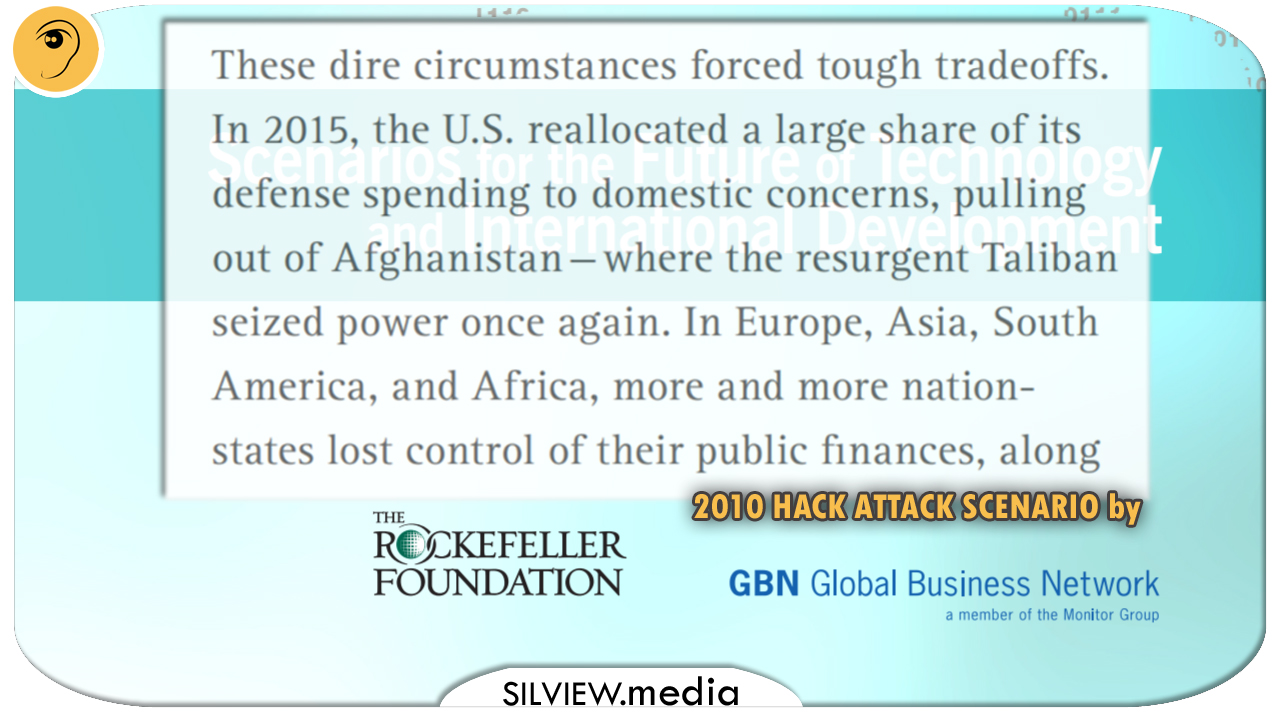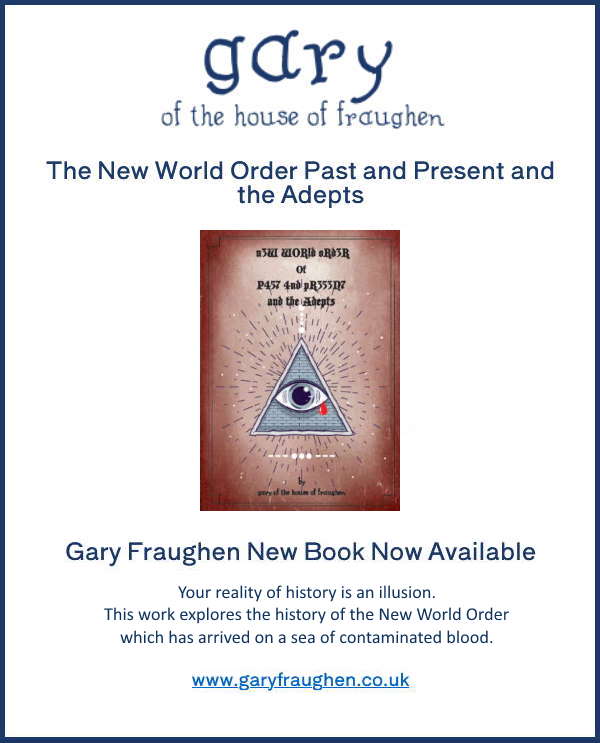Lock Step scenario flattened with bombs because we are entering the hack attack scenario?
Sun 1:02 pm +00:00, 20 Mar 2022
The notorious Lock Step Scenario, proposed by The Rockefeller Foundation in 2010, is just one chapter in a larger document titled “Scenarios for the Future of Technology and International Development”.
As the Covid narrative is being buried in the bomb craters in Ukraine, it felt like a matter of common sense to ask myself if we’re entering another chapter of the same book.

This scenario may seem, for now, not as consistent with what’s going on as Lock Step is. It will probably never be, because they learn, change and adapt faster than us.
However, I find it chillingly close to the mainstream narrative. Many of he predictions that are not confirmed yet seem very likely to occur in the near future, in my assessment. After all, we’re just starting transitioning out of Lock Step into something new.
It’s up to everyone’s awareness, experience and wit to identify analogies and decide how relevant this document is, I’m just gong to add one more dare:
My bet is that if you find the good tips about the present and near future developments in this reading, you will be ahead of the curve just like the people who picked up on the Lock Step scenario early 2020.
NOTE: Their narrative starts in 2010, the real world events started 2020. And there’s more reasons you should ignore the years in their timeline, that’s not supposed to be exact science, focus on the succession of events and their mechanisms, rather.
HACK ATTACK SCENARIO
An economically unstable and shock-prone
world in which governments weaken, criminals thrive,
and dangerous innovations emerge
Devastating shocks like September 11, the
Southeast Asian tsunami of 2004, and the
2010 Haiti earthquake had certainly primed
the world for sudden disasters. But no one
was prepared for a world in which large-scale
catastrophes would occur with such breathtaking
frequency. The years 2010 to 2020 were dubbed
the “doom decade” for good reason: the 2012
Olympic bombing, which killed 13,000, was
followed closely by an earthquake in Indonesia
killing 40,000, a tsunami that almost wiped
out Nicaragua, and the onset of the West China
Famine, caused by a once-in-a-millennium
drought linked to climate change.
Not surprisingly, this opening series of deadly
asynchronous catastrophes (there were more) put
enormous pressure on an already overstressed
global economy that had entered the decade
still in recession. Massive humanitarian relief
efforts cost vast sums of money, but the primary
sources—from aid agencies to developed-world
governments—had run out of funds to offer.
Most nation-states could no longer afford their
locked-in costs, let alone respond to increased
citizen demands for more security, more
healthcare coverage, more social programs and
services, and more infrastructure repair. In
2014, when mudslides in Lima buried thousands,
only minimal help trickled in, prompting the
Economist headline: “Is the Planet Finally
Bankrupt?”

These dire circumstances forced tough tradeoffs.
In 2015, the U.S. reallocated a large share of its
defense spending to domestic concerns, pulling
out of Afghanistan—where the resurgent Taliban
seized power once again. In Europe, Asia, South
America, and Africa, more and more nation-
states lost control of their public finances, along
with the capacity to help their citizens and
retain stability and order. Resource scarcities and
trade disputes, together with severe economic
and climate stresses, pushed many alliances
and partnerships to the breaking point; they
also sparked proxy wars and low-level conflict
in resource-rich parts of the developing
world. Nations raised trade barriers in order to
protect their domestic sectors against imports
and—in the face of global food and resource
shortages—to reduce exports of agricultural
produce and other commodities. By 2016, the
global coordination and interconnectedness
that had marked the post-Berlin Wall world was
tenuous at best.

With government power weakened, order rapidly
disintegrating, and safety nets evaporating,
violence and crime grew more rampant.
Countries with ethnic, religious, or class
divisions saw especially sharp spikes in hostility:
Naxalite separatists dramatically expanded
their guerrilla campaign in East India; Israeli-
Palestinian bloodshed escalated; and across Africa,
fights over resources erupted along ethnic or tribal lines.
Meanwhile, overtaxed
militaries and police forces could do little to stop
growing communities of criminals and terrorists
from gaining power. Technology-enabled gangs
and networked criminal enterprises exploited
both the weakness of states and the desperation
of individuals.
With increasing ease, these
“global guerillas” moved illicit products through
underground channels from poor producer
countries to markets in the developed world.
Using retired 727s and other rogue aircraft, they
crisscrossed the Atlantic, from South America
to Africa, transporting cocaine, weapons, and
operatives. Drug and gun money became a
common recruiting tool for the desperately poor.

Criminal networks also grew highly skilled
at counterfeiting licit goods through reverse
engineering. Many of these “rip-offs” and
copycats were of poor quality or downright
dangerous. In the context of weak health
systems, corruption, and inattention to
standards—either within countries or
from global bodies like the World Health
Organization—tainted vaccines entered the
public health systems of several African
countries.
“WE HAVE THIS LOVE AFFAIR
WITH STRONG CENTRAL STATES,
BUT THAT’S NOT THE ONLY
POSSIBILITY. TECHNOLOGY IS
GOING TO MAKE THIS EVEN MORE
REAL FOR AFRICA. THERE IS THE
SAME CELLPHONE PENETRATION
RATE IN SOMALIA AS IN RWANDA.
IN THAT RESPECT, SOMALIA
WORKS.”– Aidan Eyakuze, Society for International
Development, Tanzania
In 2021, 600 children in Cote d’Ivoire
died from a bogus Hepatitis B vaccine, which
paled in comparison to the scandal sparked by
mass deaths from a tainted anti-malarial drug
years later. The deaths and resulting scandals
sharply affected public confidence in vaccine
delivery; parents not just in Africa but elsewhere
began to avoid vaccinating their children, and
it wasn’t long before infant and child mortality
rates rose to levels not seen since the 1970s.
Technology hackers were also hard at work.
Internet scams and pyramid schemes plagued
inboxes.
Meanwhile, more sophisticated
hackers attempted to take down corporations,
government systems, and banks via phishing
scams and database information heists, and their
many successes generated billions of dollars in
losses. Desperate to protect themselves and their
intellectual property, the few multinationals
still thriving enacted strong, increasingly
complex defensive measures. Patent applications
skyrocketed and patent thickets proliferated,
as companies fought to claim and control even
the tiniest innovations. Security measures and
screenings tightened.
This “wild west” environment had a profound
impact on innovation. The threat of being
hacked and the presence of so many thefts and
fakes lowered the incentives to create “me first”
rather than “me too” technologies. And so many
patent thickets made the cross-pollination of
ideas and research difficult at best. Blockbuster
pharmaceuticals quickly became artifacts of
the past, replaced by increased production
of generics. Breakthrough innovations still
happened in various industries, but they were
focused more on technologies that could not be
easily replicated or re-engineered. And once
created, they were vigorously guarded by their
inventors—or even by their nations. In 2022, a
biofuel breakthrough in Brazil was protected as a
national treasure and used as a bargaining chip
in trade with other countries.

Verifying the authenticity of anything was
increasingly difficult. The heroic efforts
of several companies and NGOs to create
recognized seals of safety and approval proved
ineffective when even those seals were hacked.
The positive effects of the mobile and internet
revolutions were tempered by their increasing
fragility as scamming and viruses proliferated,
preventing these networks from achieving the
reliability required to become the backbone
of developing economies—or a source of
trustworthy information for anybody.
Interestingly, not all of the “hacking” was bad.
Genetically modified crops (GMOs) and do-it
yourself (DIY) biotech became backyard and
garage activities, producing important advances.
In 2017, a network of renegade African scientists
who had returned to their home countries after
working in Western multinationals unveiled
the first of a range of new GMOs that boosted
agricultural productivity on the continent.
But despite such efforts, the global have/have
not gap grew wider than ever. The very rich still
had the financial means to protect themselves;
gated communities sprung up from New York
to Lagos, providing safe havens surrounded by
slums. In 2025, it was de rigueur to build not
a house but a high-walled fortress, guarded by
armed personnel. The wealthy also capitalized on
the loose regulatory environment to experiment
with advanced medical treatments and other
under-the-radar activities.

Those who couldn’t buy their way out of
chaos—which was most people—retreated
to whatever “safety” they could find. With
opportunity frozen and global mobility at a
near standstill—no place wanted more people,
especially more poor people—it was often a
retreat to the familiar: family ties, religious
beliefs, or even national allegiance. Trust
was afforded to those who guaranteed safety
and survival—whether it was a warlord, an
evangelical preacher, or a mother. In some
places, the collapse of state capacity led to a
resurgence of feudalism. In other areas, people
managed to create more resilient communities
operating as isolated micro versions of formerly
large-scale systems. The weakening of national
governments also enabled grassroots movements
to form and grow, creating rays of hope amid
the bleakness.
By 2030, the distinction between
“developed” and “developing” nations no longer
seemed particularly descriptive or relevant. •

ALSO READ:
2ND BATCH OF FAUCI E-MAILS: INVITE TO ROCKEFELLER’S TRILATERAL COMMISSION
[EXCLUSIVE] FINAL EVIDENCE COVID-19 IS A ‘SIMEX’ – PLANNED SIMULATION EXERCISE BY WHO AND WORLD BANK
LOCK STEP SCENARIO FLATTENED WITH BOMBS BECAUSE WE ARE ENTERING THE HACK ATTACK SCENARIO?













